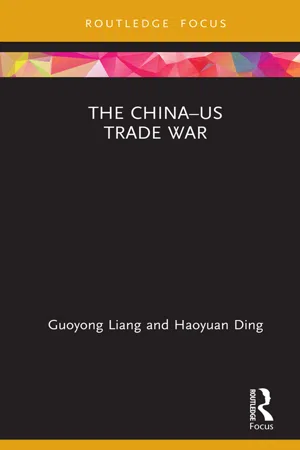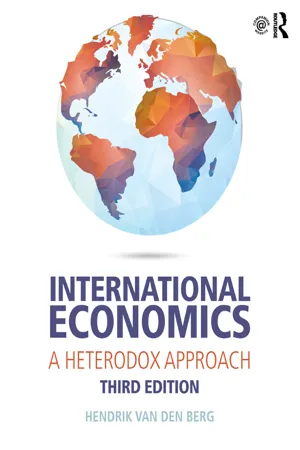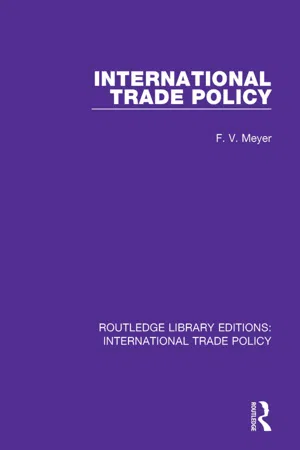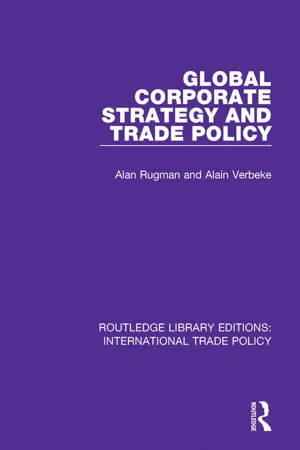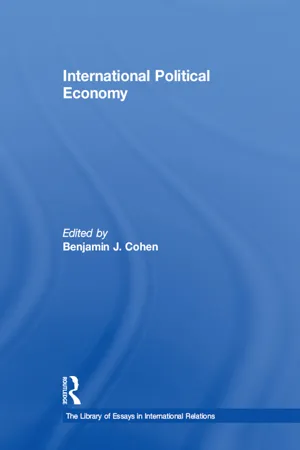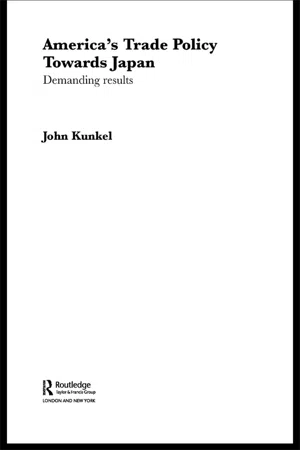History
US Trade Policy
US trade policy refers to the regulations and agreements that govern the exchange of goods and services between the United States and other countries. Throughout history, the US has implemented various trade policies to protect domestic industries, promote economic growth, and address international trade imbalances. These policies have evolved in response to changing global economic conditions and geopolitical dynamics.
Written by Perlego with AI-assistance
Related key terms
10 Key excerpts on "US Trade Policy"
- eBook - ePub
- W. Charles Sawyer, Richard L. Sprinkle(Authors)
- 2020(Publication Date)
- Routledge(Publisher)
9 , we examined the effects of tariff and nontariff barriers to trade and discussed how protectionism tends to make a country as a whole worse off. However, these effects are not uniform. The gains to consumers tend to be widely dispersed and in many cases hardly noticeable. However, the losses to domestic producers and workers are very concentrated. As a result, some firms and workers might seek protection from the government. In this chapter, we will explain why most countries provide protection to some domestic industries. We begin by analyzing the political economy of protection. Protection from imports may not be in the country’s best interest, but it is in the interest of selected special interest groups. We also explain a country’s structure of protection by describing why the tariff is high for some goods and low for others. Next, we explain what is known as administered protection as it has become difficult for governments to explicitly raise tariffs. These bureaucratic mechanisms have been developed that allow tariffs to be increased in the presence of allegedly unfair foreign competition.The second part of the chapter presents the evolution of U.S. trade policy from 1792 to today. The nature and fundamental principles of U.S. trade law are much easier to understand if you know something about its historical roots. The last section of the chapter describes the evolution of the global trading system since World War II. The WTO is the product of nearly fifty years of international trade negotiations. This section discusses the history of those negotiations, the troubled state of world trade negotiations and the issues left to be negotiated. A final section covers the current challenges to the current arrangement of international trade relations.THE POLITICAL ECONOMY OF PROTECTIONISMGiven that a country as a whole gains from trade, one would expect free trade to dominate most countries’ international trade policy. Trade barriers cost the economy more in lost consumer surplus than is gained by producers and the government. However, as we saw in the last two chapters, firms and workers in import-competing industries gain from trade barriers. As we will see in what follows, the interaction between the gains from trade for the country and the gains from trade barriers for producers explains the existence of trade barriers. The result is that free trade is not most countries’ international trade policy.In economics, policy refers to an action or actions that a government implements. For example, governments regulate industries and firms in a number of areas. These regulations are designed to modify economic activity in some way. In the presence of market failures, government regulation can improve the welfare of society. Such regulations are commonly observed for pollution or in the food and pharmaceutical industries. Not all government regulation of industries and firms works to the benefit of society as a whole; some regulations favor one segment of society. Industries and firms that benefit from regulation favor it.1 For example, it is illegal for firms to conspire to fix or raise prices. However, firms can legally raise prices if the government regulates and enforces minimum prices for an industry’s product. In this case, firms in this industry may find it in their own interest to accept regulation if it can enhance their profitability.2 - eBook - ePub
- Guoyong Liang, Haoyuan Ding(Authors)
- 2020(Publication Date)
- Routledge(Publisher)
There had long been economic conflicts between England and France. In 1664, Jean-Baptiste Colbert, the French minister of finance under Louis XIV, started to change the tariff system, which considerably raised tariffs on imported textiles. In 1666, English woolens were prohibited, and one year later, tariffs on textiles doubled. Colbert’s policy efforts drew on the ideas of mercantilism, which sought to ensure that exports exceeded imports and thus to accumulate wealth. Colbertism has become a synonym of mercantilism and protectionism. England retaliated by raising duties on French wine and started to negotiate with the French side (Priestly, 1951). However, trade diplomacy did not work, and the Anglo-French trade war rapidly escalated. Despite efforts to end the trade war in the Treaty of Utrecht in 1713, bilateral tariffs remained high during most of the 18th century. After the 1820s, the trade relationship between the two countries started to improve. In 1836, particularly, the French side abolished some imports prohibitions and reduced tariffs on major British imports, such as cotton yarn, iron products and coal (Ratcliffe, 1978). Finally, the Cobden-Chevalier Treaty in 1860 led to, on the French side, the removal of all prohibitions and a general reduction of tariffs, and, on the British side, the admission of duty free goods except for French wine and spirits. In 1881, the treaty was replaced by a most-favoured nation (MFN) convention.Evolving US trade policies since the beginning of the 20th century
The United States became the world’s largest economy at the end of the 19th century, and then turned into the world’s number one power after the two world wars. From the long-term historical perspective, the US Trade Policy has been constantly evolving, reflecting not only economic interest considerations and domestic politics, but also its global leadership and diplomatic influences.During the first half of the 20th century, the US Trade Policy went through a fundamental transformation from protectionism to reciprocity, and then to the establishment of multilateral trading system. The 1922 Fordney-McCumber Tariff Act and the 1930 Hawley-Smoot Tariff Act raised the average tariffs by 20 and six percentage points, respectively. In particular, the introduction of the latter exacerbated the consequences of the Great Depression and put global trade into unprecedented difficulties. In the context of the New Deal, the 1934 Reciprocal Trade Agreements Act delegated powers over trade policy to the executive branch. By signing bilateral agreements, the US government started to guide tariffs towards a downward trend. Right before the end of World War II, the State Department began to plan a multilateral trade agreement. In 1947, 18 countries signed the General Agreement on Tariffs and Trade (GATT) in Geneva. A multilateral trade mechanism has been established based on the principles of non-discrimination and MFN treatment and is committed to lowering trade barriers.The second half of the 20th century saw the evolution of US Trade Policy closely related to the advance of the global trading system. In the 1950s, efforts to promote free trade within the United States and at the multilateral level were not successful. In 1962, the Trade Expansion Act provided a legal basis for the United States to significantly reduce tariffs, leading to the success of the Kennedy Round – the sixth session of GATT multilateral trade negotiations held between 1964 and 1967. In the early 1970s, the world economy ushered in a turbulent era, as conflicts in international finance and trade intertwined, and the emerging trade deficit and rising unemployment reintroduced protectionism in the United States. In March 1973, the exchange rate system of the Bretton Woods system collapsed, and a floating exchange rate system debuted. At the end of the year, the oil crisis broke out. Afterwards, the Trade Act of 1974 to some extent completed the institutional construction of US Trade Policy, trying to accommodate both trade liberalization and protection in the same system. The Tokyo Round, which ended in 1979, further reduced tariff levels in developed countries. In the 1980s, with the rapid rise of trade deficit, the manufacturing industry was in dire straits, and with the rise of US trade protectionism, Japan became the primary target. - eBook - ePub
International Economics
A Heterodox Approach
- Hendrik Van den Berg(Author)
- 2016(Publication Date)
- Routledge(Publisher)
In summary, recent trade agreements, whether the recent multilateral agreements under the Uruguay and Doha Rounds or the regional agreements like NAFTA, TPP, or TTIP, have expanded way beyond simple provisions to open the borders to the free flow of goods and services. Increasingly, they are worded to protect private investment and increase the power of private business firms over national governments. Unauthorized leaks from the mostly secret negotiations that lead up to the public disclosure of the final documents suggest that some of the provisions that find their way into these agreements are actually written by representatives of private business and financial firms and brought into the negotiations by representatives of the governments involved in the negotiating process. This brings up the obvious question of whether the public interest is served by giving private transnational corporations greater freedom and power over national governments.Chapter Summary
1. Political science provides a number of models that apply to trade policy, and these models suggest various reasons why tariffs, quotas, and other trade restrictions vary across time and countries. Especially relevant to modern democracies is the uninformed voter model, which shows that there is likely to always be some trade protection.2. History shows that international trade policy has changed directions often as economic, social, political, and technological conditions have changed.3. From 1500 through the early 1800s, many countries followed mercantilist policies that protected domestic industry and pushed governments to colonize foreign societies.4. In the nineteenth century, Britain and much of the rest of Europe greatly reduced trade barriers by negotiating bilateral trade agreements that contained most favored nation clauses.5. The United States, on the other hand, more often protected its new industries throughout the nineteenth century.6. Around the middle of the nineteenth century, China and Japan were forced by European and U.S. military pressure to open their economies to trade. Free trade is not always voluntary.7. After World War I, the world took a more protectionist turn that culminated with the U.S.’s infamous Smoot–Hawley Tariff in 1930, which triggered a trade war that caused international trade to decline drastically.8. - eBook - ePub
The Nafta Puzzle
Political Parties And Trade In North America
- Charles Doran, Gregory P Marchildon(Authors)
- 2019(Publication Date)
- Routledge(Publisher)
4 What Forces Shape American Trade Policy?Timothy J. McKeownAlthough foreign trade, historically, has represented a smaller proportion of national income in the United States than in many other advanced capitalist states, American trade politics has been the subject of some of the most influential works in American political science. These studies have been motivated partly by the historical importance of trade issues in American politics, and partly by the fact that in dealing with foreign trade, economic theory has developed to the point where the distributional consequences of various policies are understood with unusual clarity. The latter condition seems to have made trade politics the social scientific equivalent of the biologists' fruit fly, that is, a naturally occurring "test bed" on which one can try out all sorts of theories about why a given policy measure might prevail. As a result, we have studies of trade policy that attribute central importance to everything from the alignment and relative strength of the great powers to the role of ideas in policy-making, from brutally simple interest group calculations of pecuniary gain to the role of the design of government institutions in favoring one type of interest at the expense of another.In this chapter, I assess previous studies of trade politics in the United States and elsewhere in order to identify some general features of the making of trade policy that could be relevant to the consideration of NAFTA. The first section covers the most common explanation for trade politics, theories based on the actions of private interest groups, and discusses some special features of interest group politics surrounding NAFTA. Addressing the role of political parties in trade politics, in particular how shifts in comparative advantage affect parties's positions on trade issues, the second section shows that conclusions depend on assumptions about both the relative political strength of old and new industries, and the degree of "stickiness" in the redeployment of economic resources. Next I ask how macroeconomic conditions and governments' macroeconomic policies affect the making of trade policy, concluding that the macroeconomic environment of the 1980s partly explains recent American trade policy. Finally, I assess the thesis that the ideologies of relatively unconstrained public officials are central to understanding trade policy, and critique the most widely cited empirical evidence for it. - eBook - ePub
- F.V. Meyer(Author)
- 2017(Publication Date)
- Routledge(Publisher)
3 UNITED STATES TARIFF POLICY A. THE EMERGENCE OF US FOREIGN ECONOMIC POLICY1. Increasing Returns
The country which has exerted most influence over twentieth-century commercial development is the US. This is not just the result of the size of her economy. At least equally important is that she pioneered the new R & D intensive industries and the international trade policy which suits the needs of those industries. The combined effect of these developments has made the US the ‘centre’ of the twentieth-century commercial world, in the sense that she has become the world’s largest producer and trader, and that her approach to international commercial relations has been the major influence over international commercial conduct in the third quarter of the century. The means through which this influence has been exercised is trade agreements. These could not have been concluded without changes in tariff policy which, in turn, coincided with or followed changes in the nature of US industries.The tariff issue came to the fore towards the end of the nineteenth century, when the US became a net exporter of merchandise.1 In other words, she had become able to produce more than needed to satisfy domestic requirements. The Secretary of State at the time held 'the opinion that the US has reached a point where one of its highest duties is to enlarge the area of its foreign trade’, and that it would not be ‘an ambitious destiny for so great a country…to manufacture only what we can consume, or to produce only what we can eat’.2 Before then, the tariff had been regarded as a revenue issue or a protectionist device to secure the home market for home producers, and not much thought seems to have been given to the use of tariff rates as bargaining counters to secure export outlets. Exports were of subsidiary interest, at least until the US market had become largely independent of European supplies of industrial goods. When this stage was reached first in this industry and then in that, traditional views of the tariff issue came under scrutiny. In a way, the US had become another Europe, able to supply her own basic industrial requirements. Further growth of production in existing industries gave rise to the question of where to dispose of the surpluses. There was a fear that domestic productive resources could not be fully employed, unless there were outlets for US products in foreign markets. Not surprisingly this led to a reconsideration of the tariff issue and the first attempts to use US tariff rates as a bargaining counter in trade agreements.3 - eBook - ePub
A National Policy for Organized Free Trade
The Case of U.S. Foreign Trade Policy for Steel, 1976-1978
- Michael W. Hodin(Author)
- 2017(Publication Date)
- Routledge(Publisher)
There has developed a willingness within the chambers of American government trade policymaking circles to talk of the global trading order in terms of organizing markets, monitoring production levels, limiting imports, and setting price guidelines. All of these point to an orientation different from the liberal ideas advocated by Cordell Hull, and codified in the General Agreement on Trade and Tariffs (GATT). Hence, the United States, in some respects as a reaction to the policies of its major trading partners, seems to be concluding that the system of (classical) free trade 1 is no longer applicable. But the neoprotectionist policies of the thirties, 2 and against which the post-war liberal trading order was created, are not looked upon as acceptable either. So, U.S. policymakers found that domestic pressures forced them to consider policies of intervention in the steel trade to protect affected constituencies from the adjustment costs largely created by the international political economy of steel. The willingness, indeed the political necessity, to develop strategies for intervening in international trade represents a change in how U.S. policymakers view the policy options available to them — i. e., the kinds of operating procedures they will apply to the complex questions of international trade in industrial sectors. This change marks a departure from liberal trade policies where there is minimal government policy of involvement in international trade, to an interventionist trade policy where government assumes an active role in assisting its domestic constituencies to cope with the dislocative effects of the international trading order. The basic proposition of this study, therefore, is that the operating procedures of the United States foreign trade policy are changing, and that the change represents a successful effort to move from liberal policies toward a new principle of the international trading order — intervention - eBook - ePub
- Alan M. Rugman, Alain Verbeke(Authors)
- 2017(Publication Date)
- Routledge(Publisher)
10 The 1934 Reciprocal Trade Act allowed the executive branch of government to negotiate reciprocal tariff reductions up to 50 per cent of existing levels with other nations.After World War Two, the US free trade policy became even more predominant. Two major principles of trade policy were formulated. The first one suggested that international political interests should dominate trade issues. The second one implied that free trade would, in the long run, generate the most effective economic results for the United States (quadrant 1 of Figure 6.1 ).There were a number of ‘exceptions’ to this policy. First, all presidents since Eisenhower have protected industries with high lobbying power, such as textiles, steel and footwear. In these cases, sheltering strategies were implemented, using import-restricting tools. Second, limited export-promoting incentives were provided to US firms such as American Export-Import Bank financing and tax advantages. These partly compensated for sometimes much larger incentives granted by other nations to their firms. In the latter cases, FSA-developing policies were used.Within the executive branch, the possibilities of implementing sheltering policies were limited, as protectionist views in one department (such as Commerce or Labor) would be confronted with the free trade preferences of other departments (usually Treasury and State). The leading role performed by the United States in the past seven GATT rounds demonstrates that an overall executive branch preference existed for free trade and for the elimination of international trade barriers.Today, however, trade policy is no longer insulated against short-run protectionist tendencies in Congress. The perception by Congress that free trade policies resulted in major negative effects for a number of US industries affected by international rivalry (a perceived shift from quadrant 1 to quadrant 2 in Figure 6.1 ) led to the quasi-protectionist Trade Acts of 1974, 1979, 1984 and 1988 (an intended shift to quadrant 3 in Figure 6.1 - eBook - ePub
- Benjamin J. Cohen(Author)
- 2017(Publication Date)
- Routledge(Publisher)
The next sections examine three types of protectionist policy. Two themes are repeated. First, each section argues for the uniqueness of that type of policy. Each policy is identified with a set of legitimating ideas, with an organizational design that translates these ideas into law, and with a unique set of political processes. Once established that there exist three different types of legal institutions, data on the extent of change in protectionist institutions are examined. Highlighted is the finding that the U.S. is not simply becoming more protectionist over time. Although state responsiveness has risen, the more interesting variations are between types of aid, not over time.The liberal ideaIn the postwar period, America’s commercial policy has centered on the creation and perpetuation of a liberal trade regime. As envisioned after World War II, that regime called for the opening of national borders to the free flow of goods, services, and capital. Although many aspects of the liberal regime were never accepted by America’s trading partners, the U.S. has continually attempted to inculcate the neoclassical economic view of trade into international practice.Although components of the liberal regime, most particularly the General Agreement in Tariffs and Trade (GATT), have come under criticism, support for liberalism has only minimally eroded among American central decision-makers. Liberalism still holds a social position not unlike a “sacred cow” in the policymaking community. In content, America’s liberal ideas stem from two intellectual roots: 19th-century British thought and 18th-century American political philosophy.The institutionalization of the liberal idea of free trade can be dated to 1934. Although entertained as a policy earlier in the 19th century (for example, see debate on Walker tariff, 1846), it was only after 1934 that American central decision-makers looked to free trade ideas as a basis of policy. The primary event that prefaces this move to liberalism is the Great Depression. The failure of the Smoot–Hawley tariff of 1929–30 to deal with economic decline set up a policymaking crisis. The delegitimization of protectionism forced the political community to search for an alternative theoretical approach to explain past errors and provide guidelines for future behavior.Economic decline breeds numerous interpretations. The Great Depression was no exception. Two sets of events allowed for the particular shift towards free trade. First, institutional responsibility for tariff-making shifted to the executive. A Democratic Congress relinquished its constitutionally granted mandate under the guidance of a strong Democratic president. Party discipline alone, however, does not explain this change. The president needed to have a cognitive explanation of the interconnections between electoral misfortune, the Great Depression, and the protectionist policies of earlier administrations to gain congressional agreement. These connections were made repeatedly to the President and Congress by “free traders” such as Secretary of State Cordell Hull. - eBook - ePub
America's Trade Policy Towards Japan
Demanding Results
- John Kunkel(Author)
- 2003(Publication Date)
- Routledge(Publisher)
Figure 2.1 shows the continued integration of the United States into the international economy. Total trade in goods and services (exports plus imports), imports and manufactured imports have continued to rise as a share of US gross domestic product (GDP). Import volumes rose at an annual growth rate of over 6 per cent between 1965 and 2000 and import elasticity increased in the 1990s. Between 1990 and 2000, US merchandise import volumes grew at an average rate of 8.5 per cent per annum and America’s share of world merchandise imports rose from 14.8 to 19.4 per cent (WTO 2001a).In terms of policy instruments, the general picture is one of low tariffs with pockets of high protection, but no generalised move towards closure. Reciprocal tariff bargaining has seen the average applied tariff rate of the United States fall to 4.1 per cent and all tariff rates are bound (WTO 2001b). The major long-term departures from this overall trend have been quantitative restrictions on maritime services, textiles, apparel and footwear and parts of the agricultural sector. In addition, since the late 1960s,a number of standardised-technology manufacturing industries with long-term structural adjustment problems have gained varying levels of protection. According to one estimate, the share of US imports affected by some form of non-tariff barrier (NTB) increased from 36 per cent in 1966 to 45 per cent in 1986 (Laird and Yeats 1990). More recent analysis suggests that the share of US tariff lines subject to NTBs has declined from over 20 per cent in the late 1980s to 3 per cent in 1996 (OECD 1997). Simultaneous moves towards greater openness in some areas and increased closure in others make neat conclusions about trends in US protection difficult to draw. For example, the United States has consistently been the world’s most active user of anti-dumping and countervailing duty measures. But Uruguay Round commitments and continued strong import growth point to the maintenance of American openness to trade.3 - eBook - ePub
- Andrew Marrison(Author)
- 2002(Publication Date)
- Routledge(Publisher)
The ‘lessons of history’, coupled with though distinct from the legacy of history, and the creation of an axiomatic link between the promotion of free trade and political freedom, were central to the American rhetoric on, first, the ITO and then the GATT. Historians have studied how statesmen employed readings of history (often highly selective or just plain erroneous ones) to make crucial decisions, but less attention has been paid to the role of historians in the evolution of policy. The chapter will explore, although by no means offer a comprehensive account of, how the lessons of the past were defined by the US government and the roles played by professional and amateur historians in shaping contemporary policy, as well as their later historical accounts of American foreign policy in general and its trading policy in particular.The ghost of trade negotiations past
A southern Democrat who was a key ally in Roosevelt’s management of the Democrat party, Cordell Hull, professed that, from the outbreak of the First World War, he had come to believe that ‘if we could increase commercial exchanges over lowered trade and tariff barriers…we would go a long way to eliminating war itself.’ Implicit in his somewhat eccentric account of the origins of the war was a vision of British free-trading history in the nineteenth century, which, so Hull believed, had brought stability to the world at a time when the United States ‘had no permanent policies to deal with the international economic situation and its relations to tariffs.’10 Like most of the American political elite, Hull was proud of his ‘pure Anglo-Saxon [but] revolutionary background’, and coupled with his strong interest in history, his formal and political education was imbued with a view of British history which identified free trade with the growth of British power in the nineteenth century and imperialism and protectionism with the origins of the First World War. In this he was also strongly influenced by the Woodrow Wilson and Democratic party debates on the style and content of American internationalism around the time of the Paris Peace Conference.11Much of Hull’s argument was unoriginal. Manufacturing and trade had long been cornerstones of American foreign policy, although the determination to safeguard the continued growth of American trade was closely tied to a concept of national interest which also provided ready encouragement to protectionist lobby groups. The contradiction was apparent throughout Herbert Hoover’s tenure as Secretary of Commerce and as President. His trade policies reflected both the American desire to trade overseas and to incorporate its economic interests into the prosecution of foreign policy, alongside the contradictory impulse to protect the domestic market. The ambiguity encouraged a ‘schizophrenic’ American position on tariffs which advocated the expansion of American trade through the ‘Open Door’ policy at the same time as encouraging high protective duties—a tension underlined by the imposition of the notorious Hawley-Smoot tariff.12
Learn about this page
Index pages curate the most relevant extracts from our library of academic textbooks. They’ve been created using an in-house natural language model (NLM), each adding context and meaning to key research topics.

